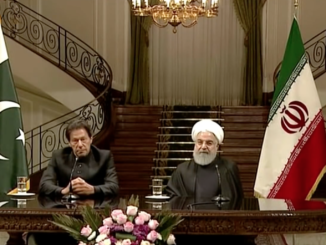
Today, the utility of the satellite-based objects for civilian and military activities has increasingly grown leading to an expansion of space programs and an ever-augmenting militarization of outer space. Likewise, the outer space has now come to be consensually accounted as a contested and competitive domain. Accordingly, the unfolding of rapid developments indicative of an expeditious progression from space militarization to weaponization has increasingly become an issue of concern given its potentially destabilizing consequences with the threat of space warfare being the foremost concern.
The cold war period of the 1970s and the early 1980s witnessed the deployment of Anti-Satellite weapons with operational status. However, this was soon followed by an exceptional hiatus for two decades with states refraining from making further developments in this domain on the premise that it would be detrimental to their interests. This intermediate period was marked by the widespread notion that space although being a militarized zone was not yet a weaponized one. However, today, it has become increasingly evident that states have embarked upon a path of overt weaponization of space. China and the United States have already demonstrated their kinetic anti-satellite weapons capability in the years 2007 and 2008 respectively while further complementing it by increasingly bellicose rhetoric originating from the civilian and military authorities linking the future of warfare with space superiority.
As of late, India has also joined this group of states with the successful conduct of mission Shakti and the capability itself remains within the grasp of several other nations given the technology’s ease of accessibility. India’s ASAT test conducted on March 27, 2019, has gestured India’s overt intent at weaponizing space. This latest development has increased the threats of other capable powers following the suit for the fear of being left behind. These offensive counter-space technologies can produce high debris which themselves function as weapons. Moreover, Russia is now expected to follow the same trajectory by demonstrating its hit-to-kill capability in outer space and has already successfully undertaken a series of launches delivering manoeuvrable spacecraft in the years 2013 and 2014 which can be potentially employed as weapons.
Besides these hit-to-kill methods, these aforementioned states have also been developing soft kill methods inclusive of laser systems and cyber capabilities having the potential of incapacitating the functionality of the enemy satellites as well as the electromagnetic pulse weapons having the ability to interfere with belligerent satellite’s communications. As opposed to hit-to-kill methods, recent decades have witnessed the employment of the soft-kill space weapons against the adversary’s satellite-based objects. In 2005, China claimed to have blinded a satellite using a laser gun. Additionally, it was in the year 2006 that China allegedly made attempts to blind a US spy satellite. In 2011, a US unmanned armed vehicle was reportedly brought down by Iran through the employment of jammers. Moreover, Iran and North Korea have also been developing jammers, lasers and high-power microwaves and some states have also demonstrated their cyber warfare capabilities compromising the enemy satellites. Reportedly, two US satellites had been compromised in 2007 and 2008 respectively through attacks allegedly originating from China. Moreover, in 2014, a US National Oceanic and Atmospheric Administration was hacked followed by the hacking of US National Aeronautics and Space Administration satellite in the year 2018.
The rapid deployment of space weapons has, therefore, amplified the risk of a new arms race in outer space as well as the potential employment of destructive space weapons in the course of warfare. The United States’ and France’s proclamation of installing a space force has further sparked the debate about the weaponization of space. In principle, the US Space force is required to support earth based military operations and to defend the space-based assets. However, given that President Trump also explicitly stated the Space Force’s mission in terms of dominance, it is presumable that it would be a fighting force. France’s announcement of the creation of weaponized satellites has also sparked debate within Europe about the weaponization of space that has the potential of causing a domino effect with other European states following the suit. The ‘inevitability thesis’ idea that the space weaponization and ultimately space warfare is inevitable- has already been incentivizing and would continue to incentivize states to make leaps forward in the domain of outer space by taking measures and counter-measures to escape this deleterious security dilemma.
Given the offence-dominant nature of space systems the ease of attacking space assets than protecting them, it is plausible that the weapons being developed for defensive purposes (space-based missile defence systems) could in the future be employed for offensive purposes. The 2019 US missile defence review emphasized the significance of space technologies required to intercept missiles in their boost phase and thereby calls for making developments in this domain. Hence, these moves altogether would ultimately provide the adversaries with a rationale to embark upon their missile defence programs in space and other capable powers to introduce their ASAT weapons. The proposed establishments also signal that the era of fighting in space-disabling or shooting down satellites on which terrestrial warfare is dependent-is getting increasingly closer.
The outer space treaty, specific weapons-based treaties and other international law accords provide no enforceable means of challenging an unrestrained weaponization of space capabilities. These existing gaps, particularly in the Outer Space Treaty, have thereby paved the way for states to embark on the path of an unchecked deployment of space weapons. While the outer space treaty bans the testing and development of weapons of mass destruction in space, it puts no strictures on the placement, development and employment of other kinetic and non-kinetic weapons in space. The treaty also fails to address the issue of the creation of space debris and the dual-use nature of space technologies which are being exploited by states to pursue the path of the weaponization of space.
The existing agreements under International law including international humanitarian law and the outer space treaty are inadequate to avert the risks of potentially destabilizing consequences associated with space weaponization in the course of their potential destructive employment. As for the international humanitarian law, although the principles including those of proportionality and precaution could apply to space weaponization in the course of warfare, but the exclusion of outer space would make the applicability of these pertinent rules dubious. Also, the dual-use nature of space objects could further complicate the applicability of IHL in such a scenario.
The treaty proposals presented to fill the existing gaps have been persistently opposed by the United States, but these proposals are neither comprehensive nor definitive as they have failed to address the dual-use dilemma, the current space militarization, or the employment of ground-based weapons to attack space assets.
It is the rapid developments in the domain of outer space that intensify the urgency of comprehensively updating the international law per the contemporary realities. To prevent any further risks, a comprehensive arms control agreement needs to be developed that could ban the use of weapons against space objects or the use of space objects against any target and prohibits the development, testing and deployment of weapons in space. The aforementioned approach may begin with the adoption of partial agreements gradually leading towards the espousal of a comprehensive treaty.
![]()




Very well written
Great article
Very well articulated!
Well-written. ?